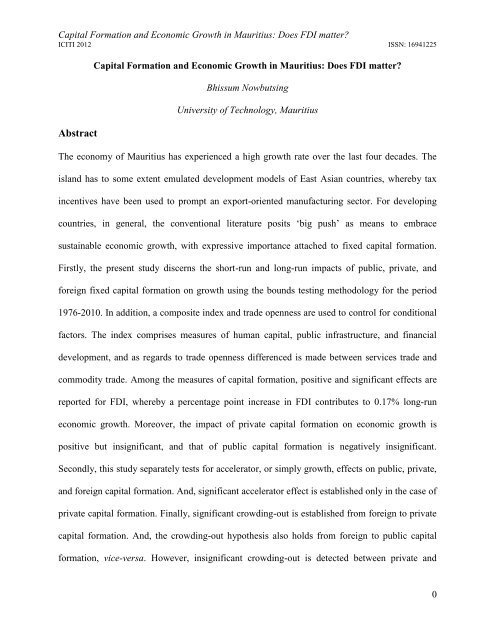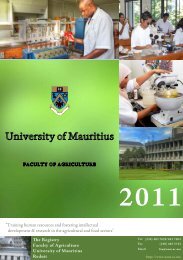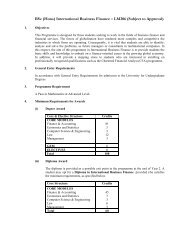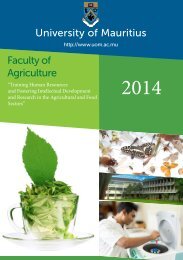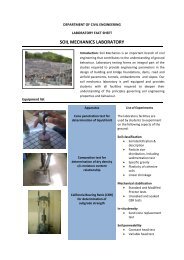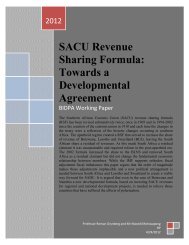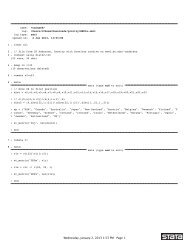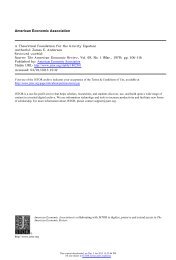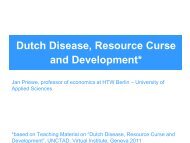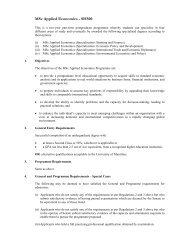Capital Formation and Economic Growth in Mauritius
Capital Formation and Economic Growth in Mauritius
Capital Formation and Economic Growth in Mauritius
Create successful ePaper yourself
Turn your PDF publications into a flip-book with our unique Google optimized e-Paper software.
<strong>Capital</strong> <strong>Formation</strong> <strong>and</strong> <strong>Economic</strong> <strong>Growth</strong> <strong>in</strong> <strong>Mauritius</strong>: Does FDI matter?ICITI 2012 ISSN: 16941225pub public gross domestic capital formation (% GDP) CSO, <strong>Mauritius</strong>edu gross secondary school enrollment (%) CSO, <strong>Mauritius</strong>roadroad density, km of road per 100 sq. km of l<strong>and</strong>areaCSO, <strong>Mauritius</strong>m2 broad money (% GDP) World Development Indicators(2012)tradesum of goods <strong>and</strong> services exports <strong>and</strong> imports(%GDP)World Development Indicators(2012)tradeserv sum of services exports <strong>and</strong> imports (% GDP)World Development Indicators(2012)tradegds sum of goods exports <strong>and</strong> imports (% GDP) World Development Indicators(2012)tax corporate tax as a share of total direct <strong>in</strong>come tax MRA, various annual reportsNote: The data set covers the period 1976-2010, except for road <strong>and</strong> fdi1 which is available as from 1980.Prelim<strong>in</strong>ary AnalysisThis part presents some observations based on table 2 <strong>and</strong> the data plots at Annex 1. It isremarkable to note that for the past four decades or so, <strong>Mauritius</strong> has constantly witnessedimprovements <strong>in</strong> real <strong>in</strong>come per-capita, <strong>in</strong> fact it has more than trebled from around Rs.60,000/year <strong>in</strong> 1976 to Rs. 190,000/year <strong>in</strong> 2010. Over the same period domestic capitalformation has hovered around the average of 30% of GDP, where private <strong>and</strong> public sectors hadan average share of 20% <strong>and</strong> 10%, respectively. The contribution of the private sector todomestic capital formation is two-fold higher than the public sector. This also confirms that s<strong>in</strong>ce1976, or perhaps earlier, <strong>Mauritius</strong> has undoubtedly benefitted the status of a mixed economy12
<strong>Capital</strong> <strong>Formation</strong> <strong>and</strong> <strong>Economic</strong> <strong>Growth</strong> <strong>in</strong> <strong>Mauritius</strong>: Does FDI matter?ICITI 2012 ISSN: 16941225a comfortable level of f<strong>in</strong>ancial services compared to other small isl<strong>and</strong>s <strong>in</strong> the Indian Oceanregion, with a notable offshore bank<strong>in</strong>g sector. In fact, the isl<strong>and</strong> embarked on f<strong>in</strong>ancial <strong>and</strong>economic liberalization <strong>in</strong> the early 1980s align<strong>in</strong>g to Structural Adjustment Programme underthe IMF.Table 2: summary statistics (without log)Variable Obs Mean Std. Dev. M<strong>in</strong> Maxrgdpc 35 112137.9 42399.59 58610.77 193067priv 35 19.93 3.26 13.42 26.07pub 35 9.27 2.18 5.28 14.28gdfcf 35 29.20 4.071 20.96 36.42fdi 35 1.15 1.45 -0.610 5.80fdi1 31 8.91 5.765 2.21 23.74trade 35 117.89 12.70 93 137tradegds 35 83.54 10.66 63 103tradeserv 35 34.34 8.25 18 48m2 35 65.74 20.81 39 103road 31 93.02 5.08 87.01 101.96edu 35 53.74 10.06 38 69tax 35 51.64 8.98 33.75 68.54absorb 35 67.08 14.68 40.64 89.70Next, tables 3 <strong>and</strong> 4 compare the gross fixed capital formation <strong>and</strong> FDI (net-<strong>in</strong>flows) for aselective sample of countries <strong>and</strong> group of countries, i.e. <strong>Mauritius</strong> <strong>and</strong> S<strong>in</strong>gapore (countries),14
<strong>Capital</strong> <strong>Formation</strong> <strong>and</strong> <strong>Economic</strong> <strong>Growth</strong> <strong>in</strong> <strong>Mauritius</strong>: Does FDI matter?ICITI 2012 ISSN: 16941225<strong>and</strong> small states <strong>and</strong> middle <strong>in</strong>come countries (group of countries). Benchmark<strong>in</strong>g <strong>Mauritius</strong>aga<strong>in</strong>st average small states <strong>and</strong> middle <strong>in</strong>come countries makes sense, s<strong>in</strong>ce it belongs to thetwo categories. Similarly, comparison with S<strong>in</strong>gapore is also justified. Notably, both countriesentered the post-colonial era with a high level of poverty <strong>and</strong> their post-<strong>in</strong>dependence growthstory s<strong>in</strong>ce mirrors each other. For S<strong>in</strong>gapore the transformation was from a fish<strong>in</strong>g village to abustl<strong>in</strong>g economy. And for <strong>Mauritius</strong> it was from sugar-based to a five-pillar economy.Table 3: gross fixed capital formation (% GDP)Selective sample 1980 1990 2000 2010<strong>Mauritius</strong> 27 36 28 29S<strong>in</strong>gapore 39 31 30 24Small states 25 24 23 24Middle <strong>in</strong>come Countries 24 23 23 27Source: World Development Indicators (2012)Table 4: fdi net-<strong>in</strong>flows (% GDP)<strong>Growth</strong>Selective sample 1980 1990 2000 2010(%)<strong>Mauritius</strong> 0.10 1.55 5.80 4.43 4430S<strong>in</strong>gapore 10.42 15.45 17.19 18.13 74Small states 2.32 2.23 4.29 5.13 221Middle <strong>in</strong>come Countries 0.56 0.73 2.57 2.60 464Source: World Development Indicators (2012)In terms of fixed capital formation, <strong>Mauritius</strong> expended more than small states <strong>and</strong> middle<strong>in</strong>come countries, on average. <strong>Mauritius</strong> <strong>and</strong> S<strong>in</strong>gapore have achieved more or less similar levels15
<strong>Capital</strong> <strong>Formation</strong> <strong>and</strong> <strong>Economic</strong> <strong>Growth</strong> <strong>in</strong> <strong>Mauritius</strong>: Does FDI matter?ICITI 2012 ISSN: 16941225of capital formation as a percentage of GDP, however, S<strong>in</strong>gapore show<strong>in</strong>g 6% decl<strong>in</strong>e for thelast decade.Regard<strong>in</strong>g foreign capital, for the past four decades FDI (as % GDP) <strong>in</strong> <strong>Mauritius</strong> experiencedremarkable progress with growth rate of more than 4000%. To lesser extents, small states <strong>and</strong>middle <strong>in</strong>come countries have witnessed generally upward trends, with average growth <strong>in</strong> FDIfar<strong>in</strong>g at 221% <strong>and</strong> 464%, respectively. Although, <strong>Mauritius</strong> outperforms S<strong>in</strong>gapore <strong>in</strong> terms ofFDI growth, the situation is reversed when compar<strong>in</strong>g the size of FDI itself. For <strong>in</strong>stance, theshare of FDI for <strong>Mauritius</strong> was 100 times lower than S<strong>in</strong>gapore <strong>in</strong> 1980 (0.10 compared to10.42). Interest<strong>in</strong>gly, this gap has been significantly reduced <strong>in</strong> 2010, i.e. to only 4 times (4.43compared to 18.13). While the performance of <strong>Mauritius</strong> is commendable on this count, there isyet room for progress <strong>and</strong> considerable FDI promotion to match S<strong>in</strong>gapore‟s achievements.As prelim<strong>in</strong>ary results to the empirical model proposed earlier, partial relationships betweenforeign or private or public capital formation <strong>and</strong> real <strong>in</strong>come per capita are given <strong>in</strong> figure 1, for<strong>Mauritius</strong> cover<strong>in</strong>g the period 1976-2010. A positive <strong>in</strong>fluence on economic growth can beobserved for both FDI <strong>and</strong> private <strong>in</strong>vestment as demarcated the l<strong>in</strong>e of best fit. Conversely, forpublic <strong>in</strong>vestment an <strong>in</strong>verse relationship can be observed. Thus, we may <strong>in</strong>fer that private <strong>and</strong>foreign capital formations are more desirable for growth, compared to public capital formation.While this posits public capital formation as detrimental to growth, it is beyond the scope of thepresent study to assess whether public capital offers more social than economic returns, <strong>and</strong>externality effects that public capital goods such as road, schools, hospital, etc., may have oneconomic growth.16
1111.51212.5111111.511.5121212.512.5<strong>Capital</strong> <strong>Formation</strong> <strong>and</strong> <strong>Economic</strong> <strong>Growth</strong> <strong>in</strong> <strong>Mauritius</strong>: Does FDI matter?ICITI 2012 ISSN: 16941225Figure 1: impact of capital formation on growthrgdpc <strong>and</strong> privrgdpc <strong>and</strong> pub2.6 2.8 3 3.2 3.4priv1.6 1.8 2 2.2 2.4 2.6pubrgdpc <strong>and</strong> fdi-3 -2 -1 0 1 2FDIUnit root testAlthough aggregate time series tend to be I(0) or I(1), studies such as Harris (2003) <strong>and</strong> Johansen(1995) have contended the existence of I(2) stationary variables. In cases where variables are I(2)stationary, long-run regression tend to be spurious. Also, the ARDL bounds tests procedure is<strong>in</strong>valid when variables are I(2). 8 Therefore, it is crucial to exam<strong>in</strong>e the stationarity status of allvariables <strong>in</strong>cluded <strong>in</strong> the model, to ensure that they are not I(2) or beyond. To assess the order of<strong>in</strong>tegration of the variables the st<strong>and</strong>ard the Augmented Dickey-Fuller (ADF) <strong>and</strong> the Phillips-8 Accord<strong>in</strong>g to Ouattara (2004) the computed F-statistics provided by Pesaran et al. (2001) are not valid for I(2)variables. This is because the lower or upper bounds are assumed to be I(0) or I(1).17
<strong>Capital</strong> <strong>Formation</strong> <strong>and</strong> <strong>Economic</strong> <strong>Growth</strong> <strong>in</strong> <strong>Mauritius</strong>: Does FDI matter?ICITI 2012 ISSN: 16941225Perron (PP) tests are used. 9Table 5, presents the results <strong>and</strong> justifies the order of <strong>in</strong>tegration ofeach variables identified. 10Table 5: Unit root test for variables (<strong>in</strong> log form)level formdifference formVariablesADF Phillips-Perron ADF Phillips-PerronDecisionZ(t)P-P-P-P-Z(t)Z(t)Z(t)ValueValueValueValuergdpc (c, t) -2.736 0.2215 -2.302 0.4330 -3.480 0.0416 -5.123 0.0001 I(1)priv -2.183 0.0188 -1.958 0.3051 -3.076 0.0024 -4.361 0.0003 I(1)pub -1.558 0.0652 -4.577 0.0002 -4.237 0.0001 -14.683 0.0000 I(0)gdfcf -1.787 0.0420 -2.224 0.1978 -3.351 0.0011 -7.523 0.0000 I(1)fdi (c, t) -3.106 0.1049 -3.453 0.0447 -5.361 0.0000 -6.874 0.0000 I(0)fdi 1(c, t) -1.337 0.8785 -0.951 0.9504 -2.731 0.2235 -4.337 0.0028 I(1)trade -2.069 0.0236 -2.004 0.2850 -4.424 0.0000 -5.255 0.0000 I(1)tradegds -1.931 0.0315 -1.846 0.3581 -4.420 0.0001 -5.242 0.0000 I(1)tradeserv (c. t) -3.148 0.0952 -4.202 0.0045 -4.477 0.0016 -6.922 0.0000 I(0)edu (c, t) -3.558 0.0336 -2.333 0.4159 -2.722 0.2270 -6.906 0.0000 I(1)road (c, t) -2.726 0.2255 -2.549 0.3039 -3.447 0.0454 -5.570 0.0000 I(1)m2 (c, t) -2.575 0.2914 -2.902 0.1615 -2.981 0.1374 -4.696 0.0007 I(1)tax -2.942 0.1489 -3.599 0.0299 -5.0009 0.0002 -8.067 0.0000 I(0)absorb (c. t) -2.977 0.1386 -3.321 0.0802 -4.363 0.0025 -8.403 0.0000 I(1)Note:(c, t) is used to denote „constant with trend‟, otherwise „constant, no trend‟.9 These tests have been developed from sem<strong>in</strong>al studies by Dickey <strong>and</strong> Fuller (1979) <strong>and</strong> Phillips <strong>and</strong> Perron (1988).10 It is important to note that <strong>in</strong> cases where the results of the ADF <strong>and</strong> Phillips-Perron tests are different, thePhillips-Perron results are reta<strong>in</strong>ed s<strong>in</strong>ce it is powerful <strong>in</strong> reject<strong>in</strong>g the null hypothesis.18
<strong>Capital</strong> <strong>Formation</strong> <strong>and</strong> <strong>Economic</strong> <strong>Growth</strong> <strong>in</strong> <strong>Mauritius</strong>: Does FDI matter?ICITI 2012 ISSN: 16941225Consistent with theory, FDI <strong>and</strong> public <strong>in</strong>vestment are I(0) s<strong>in</strong>ce they represent the firstdifferenceof foreign <strong>and</strong> public capital stock, respectively. Regard<strong>in</strong>g private <strong>in</strong>vestment theADF test confirms stationary status while the PP test confirms for I(1). In addition, strong timetrend is detected for variable edu, road, <strong>and</strong> m2. Therefore, based on the unit root test presentedabove it is confirmed that all selected variables are I(d), where 0 ≤ d ≤ 1, i.e. decision columnshows status for each variable. Thus, warrant<strong>in</strong>g adoption of the ARDL procedure, whichrequires all variables <strong>in</strong>cluded <strong>in</strong> a model to be either I(0) or I(1).Correlation matrixA correlation matrix is constructed to detect co-movements <strong>and</strong> nature of relationships betweenvariables, as per table 6. Both private <strong>in</strong>vestment <strong>and</strong> FDI are positively associated with real<strong>in</strong>come per capita, while the reverse is true for public <strong>in</strong>vestment. Similarly, positive relationshipis found between FDI <strong>and</strong> private <strong>in</strong>vestment, <strong>and</strong> negative association exists between FDI <strong>and</strong>public <strong>in</strong>vestment. Regard<strong>in</strong>g, control variables very strong correlation is established betweenedu, m2, road, <strong>and</strong> tradeserv. Thus, problems of multi-coll<strong>in</strong>earity may arise if these variablesare concurrently <strong>in</strong>cluded <strong>in</strong> the model. To verify the severity of coll<strong>in</strong>earity among the variablesthe variance <strong>in</strong>flation factor technique is explored.19
<strong>Capital</strong> <strong>Formation</strong> <strong>and</strong> <strong>Economic</strong> <strong>Growth</strong> <strong>in</strong> <strong>Mauritius</strong>: Does FDI matter?ICITI 2012 ISSN: 16941225Table 6: Correlation matrix of variables16
<strong>Capital</strong> <strong>Formation</strong> <strong>and</strong> <strong>Economic</strong> <strong>Growth</strong> <strong>in</strong> <strong>Mauritius</strong>: Does FDI matter?ICITI 2012 ISSN: 16941225Variance <strong>in</strong>flation factor (vif)First, we regress a general model <strong>and</strong> then apply VIF technique to detect coll<strong>in</strong>earity amongpredictor variables reported below. 11 The test is used to detect variables hav<strong>in</strong>g a tolerance valuelower than 0.1, comparable to a vif of 10. The results confirm low tolerance value for edu, m2,road, <strong>and</strong> tradeserv, imply<strong>in</strong>g that these variables cannot be simultaneously <strong>in</strong>cluded aspredictors. It can therefore be argued that these variables may capture/measure the same th<strong>in</strong>gs<strong>in</strong>ce they, more or less, follow identical time paths.Table 7: variance <strong>in</strong>flation factor (general model)Variable VIF 1/VIFRoad 52.41 0.019080Edu 49.01 0.020404m2 33.26 0.030063Tradeserv 19.02 0.052581Priv 4.47 0.223525Tradegds 3.61 0.276680Fdi 2.32 0.430727Pub 2.07 0.483870Mean VIF 20.77Due to the problem of multicoll<strong>in</strong>earity encountered the follow<strong>in</strong>g remedial actions are taken.First, the total trade is selected <strong>in</strong>stead of tradeserv <strong>and</strong> tradegds. Second, a composite <strong>in</strong>dex isconstructed to represent variable edu, road, <strong>and</strong> m2. The <strong>in</strong>dex is described as absorb, which isshall capture the domestic capacity to absorb as identified <strong>in</strong> the literature section. S<strong>in</strong>ce all the11 The general model is given by: rgdpc f priv,pub,fdi,edu,m2,road,tradegds,tradeserv17
<strong>Capital</strong> <strong>Formation</strong> <strong>and</strong> <strong>Economic</strong> <strong>Growth</strong> <strong>in</strong> <strong>Mauritius</strong>: Does FDI matter?ICITI 2012 ISSN: 16941225variables concerned are reported <strong>in</strong> percentages, they can be appropriately represented asgeometric mean, or log average.absorbqi 1Z i1qorabsorbexp1qqi 1lnZ iNote, the above is more reliable than simple average when deal<strong>in</strong>g with percentage formvariables. Moreover, compared to weighted average it elim<strong>in</strong>ates any biasedness that maypotentially arise while assign<strong>in</strong>g relative weights to variables. The reduced model is specified as:gdpc t = β 0 + β 1 fdi t + β 2 pub t + β 3 priv t + β 4 trade t + β 5 absorb + e t . Table 8 confirmssignificant tolerance value for all the variables.Table 8: Variance <strong>in</strong>flation factor (reduced model)Variable VIF 1/VIFPriv 3.16 0.316660Trade 3.08 0.324910Fdi 2.34 0.427064Absorb 2.30 0.433894Pub 1.75 0.571878Mean VIF 2.532.6 Results <strong>and</strong> DiscussionThis section comprises of two parts. The first part explores both short- <strong>and</strong> long-run impact offoreign, private <strong>and</strong> public capital formation on economic growth, while controll<strong>in</strong>g for tradeopenness <strong>and</strong> absorption capacity. The latter part <strong>in</strong>vestigates short- <strong>and</strong> long-run acceleratoreffects on measures of capital formation. In addition, the dynamics between measures of capitalformation are assessed to test whether crowd<strong>in</strong>g-out hypotheses hold.18
<strong>Capital</strong> <strong>Formation</strong> <strong>and</strong> <strong>Economic</strong> <strong>Growth</strong> <strong>in</strong> <strong>Mauritius</strong>: Does FDI matter?ICITI 2012 ISSN: 16941225(i) Impact of capital formation on growthIn the ARDL bounds test<strong>in</strong>g approach, the first step is to specify the short-run effects <strong>in</strong> ECMformat so as to establish existence of long-run relationship among variables. Thus, equation [5]is transformed <strong>in</strong>to [6] as:rgdpcqgii 1tfdit0i1rgdpcqzii 1zt 1t it2privt 13pubt 14fdit 1z5 t 1pq fkrgdpct1k 1 i 1iprivtiq pi 1i[6]pubtiIn the above ARDL-ECM equation represents the drift parameter, <strong>and</strong>jare the long- <strong>and</strong>short-run multipliers, <strong>and</strong>are white noise error terms. The equation is similar to those of Engle<strong>and</strong> Granger (1987), except that it comprises a l<strong>in</strong>ear comb<strong>in</strong>ation of the lagged level variables <strong>in</strong>place of the lagged error-correction term. Follow<strong>in</strong>g Pesaran et al. (2001), co<strong>in</strong>tegration can beexpected if the long-run coefficients of all lagged level variables are jo<strong>in</strong>tly significant (i.e.values of, for i = 1,..,4). The ARDL-ECM equation is estimated <strong>and</strong> the F-test is carriedout to test the null hypothesis of no co<strong>in</strong>tegration. 12H 0: λ 1 = λ 2 =λ 3 = λ 4 = λ 5 = 0H 1 : λ 1 ≠ λ 2 ≠ λ 3 ≠ λ 4 ≠ λ 5 ≠ 0Note, the F-test follows an asymptotic non-st<strong>and</strong>ard distribution <strong>and</strong> the critical F-values areobta<strong>in</strong>ed from Pesaran et al. (2001). The test generates two asymptotic critical valuesrepresent<strong>in</strong>g the lower <strong>and</strong> the upper bounds. The two asymptotic critical bounds provide a testfor co<strong>in</strong>tegration when the <strong>in</strong>dependent variables are I(d), if <strong>and</strong> only if 0 ≤ d ≤ 1. Table 2.9compares the computed F-statistics of the model with the bounds, the f<strong>in</strong>d<strong>in</strong>gs confirms that thecomputed F-statistics is greater than the upper bound critical value at 1% significance level, the12 Accord<strong>in</strong>g to Pesaran et al. (1997), OLS coefficients of first differences are of no direct <strong>in</strong>terest to the boundsco<strong>in</strong>tegration test.19
<strong>Capital</strong> <strong>Formation</strong> <strong>and</strong> <strong>Economic</strong> <strong>Growth</strong> <strong>in</strong> <strong>Mauritius</strong>: Does FDI matter?ICITI 2012 ISSN: 16941225null hypothesis of no co<strong>in</strong>tegration is, therefore, rejected. 13 In a nutshell the results confirmsstable long run co<strong>in</strong>tegration relationship between economic growth <strong>and</strong> measures of capitalformation.Table 9: bounds test resultsDependent variable F-statistics 1% Critical F-valuesLower boundUpper boundrgdpc 14.2070 3.15 4.43Note: Critical Values are cited from Pesaran et al. (2001), Table CI (iii), Case 111: Unrestricted<strong>in</strong>tercept <strong>and</strong> no trend.The second step is about estimation of long- <strong>and</strong> short-run impacts. The long-run impacts can becaptured <strong>in</strong> the theoretical ARDL (p, q f , q p , q g , q z ) model written as follows:rgdpcqci 0t4iztbipk 1tkrgdpctkqfi 01iprivtiqpi 02ipubtiqgi 03i[7]fditiIn l<strong>in</strong>e with Bahmani-Oskooee <strong>and</strong> Ardalani (2006), out of the long-run coefficients a laggederror correction term, denoted by ECM t-1 , is generated to replace l<strong>in</strong>ear comb<strong>in</strong>ation of laggedvariables, <strong>and</strong> re-estimate the models at the optimum lags. The short-run dynamic parameters areobta<strong>in</strong>ed by estimat<strong>in</strong>g an error correction model associated with long-run estimates, as perequation [8]. Where coefficientsj represent short-run effects <strong>and</strong> coefficient of ECM t-1 , i.e., gives the speed of adjustment or convergence to long-run equilibrium. Based on Banerjee et13 The lower bound assumes that all the regressors are I(0), <strong>and</strong> the upper bound assumes I(1). If the computed F-statistics lies above the upper bound, the null is rejected, <strong>in</strong>dicat<strong>in</strong>g co<strong>in</strong>tegration. If the computed F-statistics liesbelow the lower bound, the null cannot be rejected, support<strong>in</strong>g the absence of co<strong>in</strong>tegration. If the statistics fallwith<strong>in</strong> the bounds, <strong>in</strong>ference is <strong>in</strong>conclusive.20
<strong>Capital</strong> <strong>Formation</strong> <strong>and</strong> <strong>Economic</strong> <strong>Growth</strong> <strong>in</strong> <strong>Mauritius</strong>: Does FDI matter?ICITI 2012 ISSN: 16941225al. (1993, p. 233), ifis negative <strong>and</strong> significant variables show convergence to their long-runequilibrium.rgdpctprgdpcqt i i t i i t i i t ik 1 i 1 i 1 i 1 i 1qf p g zprivpubqfdiqiztiECMt 1ut[8]Table 10 shows the results for the empirical ARDL(1,0,0,1,1,0) model. 14 The model generatesone-period lag of real <strong>in</strong>come per capita, FDI, <strong>and</strong> absorption capacity as additional variables.The coefficient of lagged of the error correction mechanism, ecm(–1), is significant at -0.11367,which imply a statistically significant adjustment coefficient. This also suggests that around onetenthof the discrepancy between the long-run equilibrium value <strong>and</strong> the current value of the real<strong>in</strong>come per capita is corrected with<strong>in</strong> one year. Several diagnostic test, <strong>in</strong>clud<strong>in</strong>g Breusch-Godfrey serial correlation LM test, ARCH test, Jacque-Bera normality test <strong>and</strong> Ramsey RESETspecification test, are used to verify the robustness of the model. More importantly, the modelhas the correct functional form, which ensures validity <strong>and</strong> reliability of results.14 The optimal lag lengths <strong>in</strong> the ARDL model are chosen by values that m<strong>in</strong>imise the Schwarz Bayesian Criterion(SBC)21
Short-runLong-run<strong>Capital</strong> <strong>Formation</strong> <strong>and</strong> <strong>Economic</strong> <strong>Growth</strong> <strong>in</strong> <strong>Mauritius</strong>: Does FDI matter?ICITI 2012 ISSN: 16941225Table 10: long-run coefficients <strong>and</strong> short-run ECMRegressorrgdpcCoefficientT-ratioPriv 0.15012 0.94133Pub -0.25668 -0.72730Fdi 0.17078 ** 2.4770Absorb 1.2843 *** 5.1386Trade 0.33426 0.60830constant 5.4709 *** 3.3459∆priv 0.017064 0.92773∆pub -0.029177 -0.92076∆fdi 0.0099382 * 2.0030∆absorb -0.46798 *** -4.3811∆trade 0.037996 0.71579constant 0.62187 * 1.8280ecm t-1 -0.11367 ** -2.4024Model Summary:ARDL(1,0,0,1,1,0)R-Squared = 0.99825F( 8, 24) = 1715 *** Diagnostic tests:Serial correlation:Functional form :F(1, 23) =F(1, 23) =0.709862.1572 *Note: * 10%, ** 5%, <strong>and</strong> *** 1%Results <strong>in</strong>dicate positive impact of private <strong>in</strong>vestment <strong>and</strong> FDI, <strong>and</strong> a negative impact of public<strong>in</strong>vestment, on economic growth. The long-run elasticity of real <strong>in</strong>come per capita with respect22
<strong>Capital</strong> <strong>Formation</strong> <strong>and</strong> <strong>Economic</strong> <strong>Growth</strong> <strong>in</strong> <strong>Mauritius</strong>: Does FDI matter?ICITI 2012 ISSN: 16941225to FDI is 0.17, which is higher than the coefficient for private <strong>in</strong>vestment at 0.15. In addition,while impact of FDI is statistically significant for both short- <strong>and</strong> long-run, significance is notestablished <strong>in</strong> the case of private <strong>in</strong>vestment. For public <strong>in</strong>vestment, although statistically<strong>in</strong>significant, results confirm retard<strong>in</strong>g effects on average real <strong>in</strong>come for both short- <strong>and</strong> longrun.Thus, <strong>in</strong> accordance to Devarajan, Swaroop, <strong>and</strong> Zou (1996) the effect of public fixedcapital formation on per-capita growth is negative.More important <strong>and</strong> significant impact rest with the absorb <strong>in</strong>dex which capture effects ofimprovements <strong>in</strong> road <strong>in</strong>frastructure, amassment of human capital, <strong>and</strong> f<strong>in</strong>ancial development. Itcan be generally be argued that long-run per-capita growth is critically elastic to changes <strong>in</strong>capacity to absorb, whereby a percentage po<strong>in</strong>t improvement <strong>in</strong> the <strong>in</strong>dex contributes to 1.28percent <strong>in</strong>crease <strong>in</strong> long-run per-capita growth. For trade openness a positive but <strong>in</strong>significant isreported, lend<strong>in</strong>g to the argument that while freer trade may be beneficial it is not a criticalfactor, also given that the level of openness has always been high for <strong>Mauritius</strong>. Thus,contend<strong>in</strong>g that trade openness is a factor that can be assumed to be very high across small isl<strong>and</strong>economies. However, accord<strong>in</strong>g to Read (2010) heavy reliance upon <strong>in</strong>ternational trade canmagnify even small trade shocks <strong>in</strong>to a large impact, result<strong>in</strong>g <strong>in</strong> high growth volatility.In a nutshell, compared to domestic capital formation, FDI appears to be an important driver ofthe per-capita growth. The growth performance experienced by <strong>Mauritius</strong> can be attributed todomestic capacity to absorb, which altogether comb<strong>in</strong>es road <strong>in</strong>frastructure, f<strong>in</strong>ancialdevelopment, <strong>and</strong> human capital prove.(ii) Accelerator effects <strong>and</strong> crowd<strong>in</strong>g-out hypothesesIn general, accelerator effect refers to the positive impact of economic growth on changes <strong>in</strong>capital stock. Imply<strong>in</strong>g an accelerator model represented as:23
<strong>Capital</strong> <strong>Formation</strong> <strong>and</strong> <strong>Economic</strong> <strong>Growth</strong> <strong>in</strong> <strong>Mauritius</strong>: Does FDI matter?ICITI 2012 ISSN: 16941225KcYWhere ∆K measures total capital formation, ∆Y represents change <strong>in</strong> real <strong>in</strong>come per capita, <strong>and</strong>c is a given scalar show<strong>in</strong>g the capital output ratio. In the present study, <strong>in</strong> addition to economicgrowth, the above model is modified to capture impacts of other measures of capital formation<strong>and</strong> control variables. In this connection, the ARDL procedure is applied to three models. Thefirst model posits FDI as dependent variable, while models 2 <strong>and</strong> 3 place private <strong>and</strong> public<strong>in</strong>vestment, respectively, as dependent variables. At the first stage, the bounds test is conductedfor each model <strong>and</strong> results are reported below.Table 11: Bounds test resultsModel F-statistic 1% Critical F-valuesLower boundUpper boundModel 1: fdi 1 f ( rgdpc,pub,priv,z)1.3470Model 2: priv f ( rgdpc,pub,fdi1,z)1.44553.15 4.43Model 3: pub f ( rgdpc,priv,fdi1,z)5.9448 3.41 4.68Critical Values are cited from Pesaran et al. (2001), Table CI (iii), Case 111: Unrestricted <strong>in</strong>tercept<strong>and</strong> no trendFrom the results, the computed F-statistic is below the lower critical bound for model 1 <strong>and</strong> 2.Hence, long-run co<strong>in</strong>tegration relationships cannot be established <strong>in</strong> the two cases. Follow<strong>in</strong>gKremers et al. (1992), we shall rely on the significance of coefficient for the error correctionterm as a useful <strong>and</strong> efficient way of establish<strong>in</strong>g co<strong>in</strong>tegration. Conversely, for model 3long-runco<strong>in</strong>tegration is very well established. The long- <strong>and</strong> short-run coefficients are reported below:24
Short-runLong-run<strong>Capital</strong> <strong>Formation</strong> <strong>and</strong> <strong>Economic</strong> <strong>Growth</strong> <strong>in</strong> <strong>Mauritius</strong>: Does FDI matter?ICITI 2012 ISSN: 16941225Table 12: long-run coefficients <strong>and</strong> short-run ECMRegressor Model 1 Model 2 Model 3Coefficient T-ratio Coefficient T-ratio Coefficient T-ratiorgdpc 1.0136 1.2680 0.61055 ** 2.3727 0.46745 0.86034pub -1.9893 * -1.7966 -0.2045 -1.2232 n.a n.apriv 0.74005 0.41965 n.a n.a -0.26300 -0.52364fdi1 n.a n.a -0.30512 ** -2.6144 -0.40839 * -1.6613trade 4.4586 * 1.7181 1.3084 *** 2.7564 1.7590 ** 2.3042tax -0.23056 -0.12620 0.3241 1.3521 n.a n.aconstant -30.2303 *** -3.3149 -10.5958 *** -3.1225 -10.0815 -1.4307∆rgdpc 0.64508 1.1723 0.28823 ** 2.2295 0.30077 0.89450∆priv 0.47101 0.41780 n.a n.a -0.16922 -0.54780∆pub -1.2661 * -1.9770 -0.096421 -1.3140 -0.40644 ** -2.5735∆fdi1 n.a n.a -0.14404 ** -2.5868 -0.26277 * -1.7340∆trade 2.8376 * 1.7812 0.6179 *** 3.4628 1.1318 ** 2.5433∆tax -0.14674 -0.12687 0.15220 1.2280 n.a n.aconstant -19.2400 *** -2.5971 -5.0021 *** -3.3287 -6.4868 -1.5700ecm t-1 -0.63645 *** -3.6854 -0.47208 *** -4.0341 -0.64344 *** -2.8674ModelsummaryARDL (1,0,0,0,0,0)R 2 = 0.66074F(6, 27) = 8.7641 *** ARDL (1,0,0,0,0,0)R 2 = .83304F(6, 27) = 22.4521 *** ARDL (2,0,0,0,0)R 2 = 0.48725F(6, 27) = 4.1179 ***Diagnostic Serial correlation: Serial correlation: Serial correlation:25
<strong>Capital</strong> <strong>Formation</strong> <strong>and</strong> <strong>Economic</strong> <strong>Growth</strong> <strong>in</strong> <strong>Mauritius</strong>: Does FDI matter?ICITI 2012 ISSN: 16941225tests F(1, 26) = 0.82833Functional Form:F(1, 26) = 0.0054376F(1, 26) = 0.010141Functional Form:F(1, 26) = 1.1261F(1, 26) = .081478Functional Form:F(1, 26) = 6.3159 **Note: * 10%, ** 5%, *** 1% <strong>and</strong> n.a not applicableLong-run positive accelerator effects are established for all three measures of capital formation,whereby a percentage <strong>in</strong>crease <strong>in</strong> real average <strong>in</strong>come contributes to the respective <strong>in</strong>crease <strong>in</strong>FDI, private <strong>and</strong> public <strong>in</strong>vestment by 1.0136, 0.61055 <strong>and</strong> 0.46745 percents. And, short-runaccelerator effects st<strong>and</strong> at 0.64508, 0.28823, <strong>and</strong> 0.30077, respectively. However, significantaccelerator effects are only established for private capital formation, whereas for foreign <strong>and</strong>public capital formation the accelerator effects are weak both <strong>in</strong> size <strong>and</strong> significance.Analys<strong>in</strong>g the impact of FDI on domestic fixed capital formation, vice-versa. First, crowd<strong>in</strong>g-outeffects are reported from FDI to private capital formation, where short- <strong>and</strong> long-run impactsst<strong>and</strong> at -0.14404 <strong>and</strong> -0.30512, respectively. From private <strong>in</strong>vestment to FDI, although evidenceof crowd<strong>in</strong>g-<strong>in</strong> is detected, the results are statistically weak or <strong>in</strong>significant. Second, two-waycrowd<strong>in</strong>g-out is established between public <strong>in</strong>vestment <strong>and</strong> FDI. From FDI to public <strong>in</strong>vestmentthe elasticity coefficient is significantly negative at around -0.41 for both short- <strong>and</strong> long-run.And, the impact of public <strong>in</strong>vestment on FDI is significantly negative <strong>and</strong> more important -1.2661 (short-run) <strong>and</strong> -1.9893 (long-run).The nexus between domestic private <strong>and</strong> public capital formation for <strong>Mauritius</strong> conforms to thecrowd<strong>in</strong>g-out hypothesis. The results yield a two-way crowd<strong>in</strong>g out between the two variables ofaround -0.2, however, the coefficients are not statistically significant. Thus, weak crowd<strong>in</strong>g-outis established between private <strong>and</strong> public capital formation, vice-versa.26
<strong>Capital</strong> <strong>Formation</strong> <strong>and</strong> <strong>Economic</strong> <strong>Growth</strong> <strong>in</strong> <strong>Mauritius</strong>: Does FDI matter?ICITI 2012 ISSN: 16941225Impact of trade openness is significant <strong>and</strong> positive on overall capital formation. In particular,the impact of openness is highest on FDI. For <strong>in</strong>stance, the long-run coefficient is 4.4586 for FDIcompared to 1.3084 <strong>and</strong> 1.7590 for private <strong>and</strong> public <strong>in</strong>vestment. This certa<strong>in</strong>ly imply that tradeopenness considerably improves FDI attractiveness. F<strong>in</strong>ally, a negative but <strong>in</strong>significant impactof tax is detected on FDI. In addition, the coefficient is small at -0.23056 prov<strong>in</strong>g that FDI is tax<strong>in</strong>elastic,which is <strong>in</strong> l<strong>in</strong>e with the tax literature.After estimat<strong>in</strong>g the different models, we <strong>in</strong>vestigate the stability of the long- <strong>and</strong> short-runrelationships for each model. To <strong>in</strong>fer about stability of parameters Brown et al. (1975) proposedthe cumulative sum (cusum) <strong>and</strong> cumulative sum of squares (cusumsq) tests. The cusum (<strong>and</strong>cusumsq) compares the cumulative sum of residuals (<strong>and</strong> squares of the residuals) over timewith<strong>in</strong> a set of confidence <strong>in</strong>tervals, <strong>and</strong> if the sum of residuals moves outside the <strong>in</strong>tervals at aparticular po<strong>in</strong>t the model is said to be unstable. 15 The ma<strong>in</strong> advantage with the test is that it usesthe cumulative sum of recursive residuals based on the first n observations, which is updatedrecursively <strong>and</strong> plotted aga<strong>in</strong>st break po<strong>in</strong>t. The figures reported at Annex 2 gives theCUSUMSQ plots for each model. The results confirm that parameters of each model are robust<strong>and</strong> do not suffer from structural <strong>in</strong>stability. 162.7 ConclusionIn contrast to the weak <strong>in</strong>fluence of private <strong>in</strong>vestment, we reta<strong>in</strong>ed the significant impact offoreign <strong>in</strong>vestment on long-run economic growth, thus, confirm<strong>in</strong>g the prospects that FDI holdsfor <strong>Mauritius</strong>. And, highlight the long-way to be paved to reach the S<strong>in</strong>gapore‟s model, whereFDI is around 20% of GDP compared to 5% for <strong>Mauritius</strong>. Also, though <strong>in</strong>significant, the15 For example, if the plot of the CUSUM <strong>and</strong> CUSUMSQ stays with<strong>in</strong> the 5 per cent critical bound the nullhypothesis that all coefficients are stable cannot be rejected. If however, either of the parallel l<strong>in</strong>es are crossed thenthe null hypothesis (of parameter stability) is rejected at the 5 per cent significance level.16 Note, for the cusum <strong>and</strong> cusumsq plots at annex 3, the results can be <strong>in</strong>terpreted as marg<strong>in</strong>ally significant s<strong>in</strong>ce theplot lies, more or less, on the 5% bounds.27
<strong>Capital</strong> <strong>Formation</strong> <strong>and</strong> <strong>Economic</strong> <strong>Growth</strong> <strong>in</strong> <strong>Mauritius</strong>: Does FDI matter?ICITI 2012 ISSN: 16941225negative impact of public <strong>in</strong>vestment on growth rema<strong>in</strong>s cause for concerns. While this implythat public <strong>in</strong>vestment has been unproductive, here the results can be cautiously justified if, firstwe assume public <strong>in</strong>vestment flow<strong>in</strong>g <strong>in</strong>to public capital stock such as road, schools, hospital,etc., which does not directly generate economic returns, but <strong>in</strong>stead long-run spillovers throughimproved road networks, education, health. And second, it can be argued that the l<strong>in</strong>k betweenpublic capital spend<strong>in</strong>g <strong>and</strong> public capital stock, often, if not, always rest on the sector‟s degreeof efficiency, waste, <strong>and</strong> corruption, which may imp<strong>in</strong>ge on the execution <strong>and</strong> effectiveness ofpublic projects.Accelerator effect from economic growth to capital formation is established only <strong>in</strong> the case ofprivate <strong>in</strong>vestment. Thus, confirm<strong>in</strong>g that for <strong>Mauritius</strong> economic growth is critical for domesticprivate capital formation, where high economic growth may serve as a signal to <strong>in</strong>digenousbus<strong>in</strong>ess decisions. In the case of foreign <strong>in</strong>vestment the accelerator effect is not supported <strong>and</strong>this result is supported by Blomstoerm, Lipsey <strong>and</strong> Zejan (1994) <strong>and</strong> Dritsaki et al. (2004), whorevealed found a unidirectional relationship between FDI <strong>and</strong> economic growth, with directionfrom FDI to growth. Similarly, for public capital formation the accelerator hypothesis is rejected.In particular, we showed significant crowd<strong>in</strong>g-out from foreign to private capital formation. Thismay imply that domestic firms may struggle to compete with powerful foreign firms as per Ram<strong>and</strong> Zhang (2002). In other words, local firms may be weak <strong>in</strong> respond<strong>in</strong>g competitively toforeign firms. Regard<strong>in</strong>g foreign <strong>and</strong> public capital formation, a two-way crowd<strong>in</strong>g-out isrevealed. The trade-off relationship between public <strong>in</strong>vestment <strong>and</strong> FDI can be <strong>in</strong>terpreted <strong>in</strong> twoways. Firstly, if the level of public capital formation reflects on the size of government or theextent of government <strong>in</strong>tervention/regulation or imply<strong>in</strong>g higher tax burden, then high public<strong>in</strong>vestment may directly or <strong>in</strong>directly discourage FDI. Secondly, if FDI represents a means for28
<strong>Capital</strong> <strong>Formation</strong> <strong>and</strong> <strong>Economic</strong> <strong>Growth</strong> <strong>in</strong> <strong>Mauritius</strong>: Does FDI matter?ICITI 2012 ISSN: 16941225privatization or outsourc<strong>in</strong>g, then <strong>in</strong>creas<strong>in</strong>g FDI provides the opportunity for government toprivatise or outsource some of its operation. This has been the case <strong>in</strong> <strong>Mauritius</strong> with the partialprivatization of the <strong>Mauritius</strong> Telecom <strong>in</strong> partnership with France Telecom <strong>in</strong> 2001. F<strong>in</strong>ally,weak crowd<strong>in</strong>g-out is detected between public <strong>and</strong> private capital formation.Notably, the importance of conditional factors such as f<strong>in</strong>ancial development; human capital; <strong>and</strong>road <strong>in</strong>frastructure is clearly established under the proposed absorptive capacity <strong>in</strong>dex. Giventhat <strong>Mauritius</strong> enjoys a good track record on all three fronts, the domestic absorption capacityhas also quite high, i.e. over 50% <strong>in</strong> 1976. In addition, although <strong>Mauritius</strong> has been importantlydependent on trade, openness does not exert significant <strong>in</strong>fluence of growth. However, theimpact of openness on FDI <strong>and</strong> private <strong>in</strong>vestment is well established both <strong>in</strong> the short- <strong>and</strong> longrun.Thus, on one h<strong>and</strong>, imply<strong>in</strong>g that openness to trade is important <strong>in</strong> determ<strong>in</strong><strong>in</strong>g theproductivity of both foreign <strong>and</strong> private capital formation. And, on other h<strong>and</strong>, trade shocks maysignificantly affect foreign <strong>and</strong> private capital formation <strong>in</strong> <strong>Mauritius</strong>, thus render<strong>in</strong>g domesticgrowth highly volatile. F<strong>in</strong>ally, although the impact of tax burden on foreign capital formation isnegative, it is not significant for <strong>Mauritius</strong>.ReferencesAcemoglu D., Johnson S. <strong>and</strong> Rob<strong>in</strong>son J. (2001). The Colonial Orig<strong>in</strong>s of ComparativeDevelopment: An Empirical Investigation. American <strong>Economic</strong> Review, 91, 1369 – 1401.Agos<strong>in</strong>, M. R. <strong>and</strong> Mayer R. (2000). Foreign Investment <strong>in</strong> Develop<strong>in</strong>g Countries: Does itCrowd <strong>in</strong> Domestic Investment?‟ UNCTAD Discussion Paper, No.146, Geneva: UNCTAD.Aitken B. J., Gordon H. H. <strong>and</strong> Harrison A. E. (1997), „Spillovers, Foreign Investment, <strong>and</strong>Export Behavior,‟ Journal of International <strong>Economic</strong>s, 43,103-132.29
<strong>Capital</strong> <strong>Formation</strong> <strong>and</strong> <strong>Economic</strong> <strong>Growth</strong> <strong>in</strong> <strong>Mauritius</strong>: Does FDI matter?ICITI 2012 ISSN: 16941225Aitken, B. <strong>and</strong> Harrison A. (1999). Do Domestic Firms Benefit from Direct Foreign Investment?Evidence from Venezuela. American <strong>Economic</strong> Review, 89, 605-18.Alfaro C. (2004). Argent<strong>in</strong>a: ICSID arbitration <strong>and</strong> BITs challenged by the Argent<strong>in</strong>eGovernment. Alfaro – Abogados.Alfaro L., Ch<strong>and</strong>a A., Sayek S. <strong>and</strong> Kalemli-Ozam S. (2002). FDI <strong>and</strong> <strong>Economic</strong> <strong>Growth</strong>: TheRole of Local F<strong>in</strong>ancial Markets. ECON WPA, No 112007, University of Houston.Aschauer D. A. (1989). Is Public Expenditure Productive? Journal of Monetary <strong>Economic</strong>s, 23,117-200.Balasubramanyam V. N., Salisu M. <strong>and</strong> Sapsford D. (1996). Foreign Direct Investment <strong>and</strong><strong>Growth</strong> <strong>in</strong> EP <strong>and</strong> Is Countries. The <strong>Economic</strong> Journal, 106, 92-105.Balasubramanyam V. N., Salisu M. <strong>and</strong> Sapsford D. (1999). Foreign Direct Investment as anEng<strong>in</strong>e of <strong>Growth</strong>. Journal of International Trade <strong>and</strong> <strong>Economic</strong> Development, 8:1, 27-40Bannerjee A., Dolado J., Galbraith J. W. <strong>and</strong> Hendry D. F (1993). Integration, Error Correction,<strong>and</strong> the Econometric Analysis of Non-Stationary Data. Oxford: Oxford University Press.Bengoa M. <strong>and</strong> Sanchez-Robles B. (2003). Foreign Direct Investment, <strong>Economic</strong> Freedom <strong>and</strong><strong>Growth</strong>: New evidence from Lat<strong>in</strong> America. European Journal of Political Economy, 19, 529-545.Bhagwati J. N. (1978). Anatomy <strong>and</strong> Consequences of Exchange Control Regimes. Studies <strong>in</strong>International <strong>Economic</strong> Relations, Vol. 1.30
<strong>Capital</strong> <strong>Formation</strong> <strong>and</strong> <strong>Economic</strong> <strong>Growth</strong> <strong>in</strong> <strong>Mauritius</strong>: Does FDI matter?ICITI 2012 ISSN: 16941225Bhagwati J. N. (1985). Invest<strong>in</strong>g Abroad, Esmee Fairba<strong>in</strong> Lecture. Lancaster University.Blalock, G. <strong>and</strong> Gertler, P. (2005). Welfare Ga<strong>in</strong>s from Foreign Direct Investment throughTechnology Transfer to Local Suppliers. Journal of International <strong>Economic</strong>s.Bl<strong>in</strong> M. & Ouattara, B. (2009). Foreign Direct Investment <strong>and</strong> <strong>Economic</strong> <strong>Growth</strong> <strong>in</strong> <strong>Mauritius</strong>:Evidence from Bounds Test Co<strong>in</strong>tegration. Economie Internationale, CEPII research center,issue 1Q, 47-61.Blomström M. (1992). Host Country Benefits of Foreign Investment. NBER Work<strong>in</strong>g Papers3615.Blomström, M <strong>and</strong> Kokko A. (1997). Regional Integration <strong>and</strong> Foreign Direct Investment - AConceptual Framework <strong>and</strong> Three Cases. Policy Research Work<strong>in</strong>g Paper, 1750, World Bank,International <strong>Economic</strong>s Department, International Trade Division.Blomström, M., Robert E. Lipsey, <strong>and</strong> Zejan, M. (1994). What Expla<strong>in</strong>s the <strong>Growth</strong> ofDevelop<strong>in</strong>g Countries? In Baumol, William J., Nelson, Richard R. <strong>and</strong> Wolff, Edward N. (eds.),Convergence of Productivity, Oxford University Press, New York: 243-256.Blonigen B. A. <strong>and</strong> Wang, M. (2005). Inappropriate Pool<strong>in</strong>g of Wealthy <strong>and</strong> Poor Countries <strong>in</strong>Empirical FDI Studies, <strong>in</strong> Moran T. Graham E. <strong>and</strong> Blomström M. (eds.). Does Foreign DirectInvestment Promote Development? Institute for International <strong>Economic</strong>s, Wash<strong>in</strong>gton D.C.Borenszte<strong>in</strong> E. J., Gregorio J. D. <strong>and</strong> Lee J. W. (1995). How does Foreign Direct InvestmentAffect <strong>Economic</strong> <strong>Growth</strong>? National Bureau of <strong>Economic</strong> Research Work<strong>in</strong>g Paper, 5057.31
<strong>Capital</strong> <strong>Formation</strong> <strong>and</strong> <strong>Economic</strong> <strong>Growth</strong> <strong>in</strong> <strong>Mauritius</strong>: Does FDI matter?ICITI 2012 ISSN: 16941225Borenszte<strong>in</strong> E., Gregorio J. D. <strong>and</strong> Lee J. W. (1998). How Does Foreign Direct InvestmentAffect <strong>Economic</strong> <strong>Growth</strong>? Journal of International <strong>Economic</strong>s, 45, 115-135.Borenszte<strong>in</strong>, E., J. De Gregorio, <strong>and</strong> Lee, J.W. (1995). How does Foreign Direct InvestmentAffect <strong>Economic</strong> <strong>Growth</strong>? National Bureau of <strong>Economic</strong> Research Work<strong>in</strong>g Paper, 5057.Bosworth B. P. <strong>and</strong> Coll<strong>in</strong>s S. M. (1999). <strong>Capital</strong> Flows to Develop<strong>in</strong>g Economies: Implicationsfor Sav<strong>in</strong>g <strong>and</strong> Investment. Brook<strong>in</strong>gs Papers on <strong>Economic</strong> Activity, 6, 145 - 165Braunste<strong>in</strong> E. <strong>and</strong> Epste<strong>in</strong> G. (2004). Barga<strong>in</strong><strong>in</strong>g power <strong>and</strong> foreign direct <strong>in</strong>vestment <strong>in</strong> Ch<strong>in</strong>a:Can 1.3 billion consumers tame the mult<strong>in</strong>ationals? <strong>in</strong> Milberg W.(ed.), Labour <strong>and</strong> theGlobalization of Production, Palgrave Macmillan, London.Brown R. L., Durb<strong>in</strong> J. <strong>and</strong> Evans J. M., (1975). Techniques for Test<strong>in</strong>g the Consistency ofRegression Relations Over Time. Journal of the Royal Statically Society, 37, 149-92.Castellani D. <strong>and</strong> Zanfei A. (2001). Technology Gaps, Absorptive Capacity <strong>and</strong> the Impact ofInward Investment on Productivity of European Firms. Mimeo, ISE Universita di Urb<strong>in</strong>o.Caves R. E. (1974). Mult<strong>in</strong>ational corporations, competition <strong>and</strong> productivity <strong>in</strong> host-countrymarkets. <strong>Economic</strong>a, 41, 176-193.Chakraborty C. <strong>and</strong> Basu, P. (2002). Foreign Direct Investment <strong>and</strong> <strong>Growth</strong> <strong>in</strong> India: ACo<strong>in</strong>tegration Approach. Applied <strong>Economic</strong>s, 34, 1061-73.Chenery, H.B. <strong>and</strong> Strout, A.M. (1966). Foreign Assistance <strong>and</strong> <strong>Economic</strong> Development. TheAmerican <strong>Economic</strong> Review, Volume LVI, Number 4, Part I.32
<strong>Capital</strong> <strong>Formation</strong> <strong>and</strong> <strong>Economic</strong> <strong>Growth</strong> <strong>in</strong> <strong>Mauritius</strong>: Does FDI matter?ICITI 2012 ISSN: 16941225Choe J. (2003). Do Foreign Direct Investment <strong>and</strong> Gross Domestic Investment Promote<strong>Economic</strong> <strong>Growth</strong>? Review of Development <strong>Economic</strong>s, 7, 44-57.Davidson, R. <strong>and</strong> MacK<strong>in</strong>non, J.G. (1993). Estimation <strong>and</strong> Inference <strong>in</strong> Econometrics. OxfordUniversity Press.De Gregorio (1992). <strong>Economic</strong> growth <strong>in</strong> Lat<strong>in</strong> America. Journal of Development <strong>Economic</strong>s,Elsevier, vol. 39(1), 59-84, July.De Mello R. (1997). Foreign Direct Investment <strong>in</strong> develop<strong>in</strong>g Countries <strong>and</strong> <strong>Growth</strong>: A SelectiveSurvey. The Journal of Development Studies, 34, 1-34.De Mello R. (1999). Foreign direct <strong>in</strong>vestment-led growth: evidence from time series <strong>and</strong> paneldata. Oxford <strong>Economic</strong> Papers, 51, 133-154.Dees S. (1998). Foreign Direct Investment <strong>in</strong> Ch<strong>in</strong>a: Determ<strong>in</strong>ants <strong>and</strong> Effects. <strong>Economic</strong>s ofPlann<strong>in</strong>g, 31, 175-94.Devarajan, S., V. Swaroop, <strong>and</strong> Heng-fu Zou (1996). The Composition of Public Expenditure<strong>and</strong> <strong>Economic</strong> <strong>Growth</strong>. Journal of Monetary <strong>Economic</strong>s Vol. 37, pp. 313-344.Dickey D. <strong>and</strong> Fuller W.A. (1979). Distribution of the Estimates for Autoregressive Time Serieswith Unit Root. Journal of the American Statistical Association, 74, 427-31.Djankov S. <strong>and</strong> Hoekman B. (2000). Foreign Investment <strong>and</strong> Productivity <strong>Growth</strong> <strong>in</strong> CzechEnterprises. World Bank <strong>Economic</strong> Review, 14, 49-64.33
<strong>Capital</strong> <strong>Formation</strong> <strong>and</strong> <strong>Economic</strong> <strong>Growth</strong> <strong>in</strong> <strong>Mauritius</strong>: Does FDI matter?ICITI 2012 ISSN: 16941225DurhamB. J. (2004). Absorptive Capacity <strong>and</strong> the Effects of Foreign Direct Investment <strong>and</strong>Equity Foreign Portfolio Investment on <strong>Economic</strong> <strong>Growth</strong>. European <strong>Economic</strong> Review, 48,285-306.Engle, R. F. <strong>and</strong> Granger C. W. J. (1987). Co-<strong>in</strong>tegration <strong>and</strong> Error Correction: Representation,Estimation, <strong>and</strong> Test<strong>in</strong>g. Econometrica, 55, 251-276.Feder G. (1983). On Exports <strong>and</strong> <strong>Economic</strong> <strong>Growth</strong>. Journal of Development <strong>Economic</strong>s, 12, 59-73.Fosu A. K. (1990). Export Composition <strong>and</strong> the Impact of Exports on <strong>Economic</strong> <strong>Growth</strong> ofDevelop<strong>in</strong>g Economies. <strong>Economic</strong>s Letters, 34, 67-71.Fosu <strong>and</strong> Magnus (2006). Bounds test<strong>in</strong>g approach: an exam<strong>in</strong>ation of foreign direct <strong>in</strong>vestment,trade, <strong>and</strong> growth relationships. MPRA Paper 352, University Library of Munich, Germany.Fry M. J. (1992). Foreign Direct Investment <strong>in</strong> a Macroeconomic Framework: F<strong>in</strong>ance,Efficiency, Incentives <strong>and</strong> Distortions. PRE Work<strong>in</strong>g Paper, Wash<strong>in</strong>gton, DC: The World Bank.Goldsmith R. W. (1969). F<strong>in</strong>ancial Structure <strong>and</strong> Development. New Haven, Yale UniversityPress.Granger C.W.J, <strong>and</strong> Newbold P. (1974). Spurious Regressions <strong>in</strong> Econometrics. Journal ofEconometrics, 26, 1045-1066.Granger, C.W.J, (1986). Developments <strong>in</strong> the Study of Co<strong>in</strong>tegrated <strong>Economic</strong> Variables‟,Oxford Bullet<strong>in</strong> of <strong>Economic</strong>s <strong>and</strong> Statistics. Department of <strong>Economic</strong>s, University of Oxford,vol. 48(3), pages 213-28, August.34
<strong>Capital</strong> <strong>Formation</strong> <strong>and</strong> <strong>Economic</strong> <strong>Growth</strong> <strong>in</strong> <strong>Mauritius</strong>: Does FDI matter?ICITI 2012 ISSN: 16941225Griff<strong>in</strong>, K. <strong>and</strong> Enos, J. (1970). Foreign Assistance, Objectives <strong>and</strong> Consequences. <strong>Economic</strong>Development <strong>and</strong> Cultural Change 18.Gunnar Myrdal (1957). <strong>Economic</strong> Theory <strong>and</strong> Underdeveloped Regions. London: UniversityPaperbacks, Methuen.Hall, R. E. <strong>and</strong> Jones C. (1999). Why Do Some Countries Produce So Much More Output perWorker than Others? Quarterly Journal of <strong>Economic</strong>s, Vol. 114, pp. 83-116.Hanson, Gordon H. (2001). Should Countries Promote Foreign Direct Investment? ResearchPapers for the Intergovernmental Group of Twenty-Four on International Monetary Affairs,United Nations Conference on Trade <strong>and</strong> Development. New York: United Nations, G-24Discussion Paper Series, No. 9.Harris, R. <strong>and</strong> Sollis, R. (2003). Applied Time Series Modell<strong>in</strong>g <strong>and</strong> Forecast<strong>in</strong>g. West Sussex:Wiley.Haskel, J. E., Pereira, S. C. <strong>and</strong> Slaughter, M. J. (2002). Does Inward Foreign Investment Boostthe Productivity of Domestic Firms? NBER Work<strong>in</strong>g Paper, No. 8724.Herzer, D., Nowak-Lehmann, D.F. <strong>and</strong> Siliverstovs, B. (2006). Export-led growth <strong>in</strong> Chile:Assess<strong>in</strong>g the role of export composition <strong>in</strong> productivity growth. The Develop<strong>in</strong>g <strong>Economic</strong>s,44:(3)Inder, B. (1993). Estimat<strong>in</strong>g long-run relationships <strong>in</strong> economics: A comparison of differentapproaches. Journal of Econometrics, 57, 53-68.35
<strong>Capital</strong> <strong>Formation</strong> <strong>and</strong> <strong>Economic</strong> <strong>Growth</strong> <strong>in</strong> <strong>Mauritius</strong>: Does FDI matter?ICITI 2012 ISSN: 16941225Johansen, S. (1995). Likelihood-based Inference <strong>in</strong> Co<strong>in</strong>tegrated Vector Autoregressive Models.Oxford: Oxford University Press.Johansen, S. <strong>and</strong> Juselius, K. (1990). Maximum likelihood estimation <strong>and</strong> <strong>in</strong>ference onco<strong>in</strong>tegration-with application to the dem<strong>and</strong> for money. Oxford Bullet<strong>in</strong> of <strong>Economic</strong>s <strong>and</strong>Statistics, 52, 169- 10.Kokko, A., (1994). Technology, Market Characteristics, <strong>and</strong> Spillovers. Journal of Development<strong>Economic</strong>s, 43:279-93.Kokko, A., Tans<strong>in</strong>i, R.et al. (1996). Local Technological Capability <strong>and</strong> Productivity Spilloversfrom FDI <strong>in</strong> the Uruguayan Manufactur<strong>in</strong>g Sector. Journal of Development Studies, 32(4):279-93.Kremers, J., Ericsson, N., Dolado, J. (1992).The Power of Co<strong>in</strong>tegration Tests. Oxford Bullet<strong>in</strong>of <strong>Economic</strong>s <strong>and</strong> Statistics 54: 349-67Li, X. <strong>and</strong> Liu, X. (2005). Foreign Direct Investment <strong>and</strong> <strong>Economic</strong> <strong>Growth</strong>: An Increas<strong>in</strong>glyEndogenous Relationship. World Development.Lim, D. (1983). Fiscal <strong>in</strong>centives <strong>and</strong> direct foreign <strong>in</strong>vestment <strong>in</strong> less developed countries.Journal of Development Studies, 19, 207–212.Lipsey, R.E. (2000). Inward FDI <strong>and</strong> economic growth <strong>in</strong> develop<strong>in</strong>g countries. TransnationalCorporations, 9: 61-95.36
<strong>Capital</strong> <strong>Formation</strong> <strong>and</strong> <strong>Economic</strong> <strong>Growth</strong> <strong>in</strong> <strong>Mauritius</strong>: Does FDI matter?ICITI 2012 ISSN: 16941225Lipsey, R.E. (2002a). Foreign Production by U.S. Firms <strong>and</strong> Parent Firm Employment. <strong>in</strong> RobertE. Lipsey <strong>and</strong> Jean-Louis Mucchielli, Edited, Mult<strong>in</strong>ational Firms <strong>and</strong> Impacts on Employment,Trade, <strong>and</strong> Technology: New Perspectives for a New Century, London, Routledge.Lipsey, R.E. (2002b). Foreign Direct Investment <strong>and</strong> the Operations of Mult<strong>in</strong>ational Firms:Concepts, History, <strong>and</strong> Data. <strong>in</strong> James Harrigan, Edited, H<strong>and</strong>book of International <strong>Economic</strong>s,Oxford, Blackwell.Lipsey, R.E., <strong>and</strong> Sjöholm, F. (2005). The Impact of Inward FDI on Host Countries: Why SuchDifferent Answers? <strong>in</strong> Moran, Graham, <strong>and</strong> Blomström, Editors (2005).Makki, S <strong>and</strong> Somwaru, A (2004). Impact of Foreign Direct Investment <strong>and</strong> Trade on <strong>Economic</strong><strong>Growth</strong>: Evidence from Develop<strong>in</strong>g Countries. American Journal of Agricultural <strong>Economic</strong>s, 86,795-801Mattaya, C.S. <strong>and</strong> Veeman, M.M. (1996). The Behaviour of Private <strong>and</strong> Public Investment <strong>in</strong>Malawi. Canadian Journal of <strong>Economic</strong>s, Vol. 29, Special Issue: Part 2, S438- S442Melitz, Marc J., (2005). When <strong>and</strong> how should <strong>in</strong>fant <strong>in</strong>dustries be protected? Journal ofInternational <strong>Economic</strong>s, Elsevier, vol. 66(1), 177-196, May.Mody, A. <strong>and</strong> Wang, F. (1997). Expla<strong>in</strong><strong>in</strong>g Industrial <strong>Growth</strong> <strong>in</strong> coastal Ch<strong>in</strong>a: <strong>Economic</strong>Reforms… <strong>and</strong> what else? World Bank <strong>Economic</strong> Review, 11 (2): 293-325Nair-Reichert, U. <strong>and</strong> D. We<strong>in</strong>hold (2001). Causality tests for cross-country panels: a new lookat FDI <strong>and</strong> economic growth <strong>in</strong> develop<strong>in</strong>g countries. Oxford Bullet<strong>in</strong> of <strong>Economic</strong>s <strong>and</strong>Statistics, 63 (2), 153-171.37
<strong>Capital</strong> <strong>Formation</strong> <strong>and</strong> <strong>Economic</strong> <strong>Growth</strong> <strong>in</strong> <strong>Mauritius</strong>: Does FDI matter?ICITI 2012 ISSN: 16941225Ng, S. <strong>and</strong> Perron, P. (1995). Unit Root Tests <strong>in</strong> ARMA Models with Data-Dependent Methodsfor the Selection of the Truncation Lag. Journal of the American Statistical Association, 90, 268-281.Niels, H. <strong>and</strong> Lens<strong>in</strong>k, R. (2003). Foreign Direct Investment, F<strong>in</strong>ancial Development <strong>and</strong><strong>Economic</strong> <strong>Growth</strong>. Journal of Development Studies, 40(1), 142-63.Nurkse, R. (1953).Problems of <strong>Capital</strong> <strong>Formation</strong> <strong>in</strong> Underdeveloped Countries. Oxford: BasilBlackwell.OECD (1998), „Harmful Tax Competition - An Emerg<strong>in</strong>g Global Issue‟.Oliva, M.A. & Rivera-Batiz, L.A, (2002). Political Institutions, <strong>Capital</strong> Flows, <strong>and</strong> Develop<strong>in</strong>gCountry <strong>Growth</strong>: An Empirical Investigation. Review of Development <strong>Economic</strong>s, WileyBlackwell, vol. 6(2), 248-62, June.Ouattara, B. (2004). The Impact of Project Aid <strong>and</strong> Programme Aid on Domestic Sav<strong>in</strong>gs: ACase Study of Côte d'Ivoire. Centre for the Study of African Economies Conference on <strong>Growth</strong>,Poverty Reduction <strong>and</strong> Human Development <strong>in</strong> Africa.Ouattara, B. (2005). A New Database on Project Aid <strong>and</strong> Programme Aid Disbursements <strong>and</strong> aRe-exam<strong>in</strong>ation of the Aid-Sav<strong>in</strong>gs Nexus. The School of <strong>Economic</strong>s Discussion Paper Series0501, <strong>Economic</strong>s, The University of Manchester.Panopoulou, E. <strong>and</strong> Pittis, N. (2004). A comparison of autoregressive distributed lag <strong>and</strong>dynamic OLS co<strong>in</strong>tegration estimators <strong>in</strong> the case of a serially correlated co<strong>in</strong>tegration error.Econometrics Journal, Royal <strong>Economic</strong> Society, vol. 7(2), 585-617, December.38
<strong>Capital</strong> <strong>Formation</strong> <strong>and</strong> <strong>Economic</strong> <strong>Growth</strong> <strong>in</strong> <strong>Mauritius</strong>: Does FDI matter?ICITI 2012 ISSN: 16941225Pesaran, H. <strong>and</strong> Pesaran, B. (1997). Microfit 4.0 for W<strong>in</strong>dows. Oxford University press <strong>and</strong>Polyhedron Software LTD.Pesaran, M. H. <strong>and</strong> Sh<strong>in</strong>, Y. (1998). An Autoregressive distributed lag model<strong>in</strong>g approach toco<strong>in</strong>tegration analysis. <strong>in</strong> S. Storm, ed., Econometrics <strong>and</strong> <strong>Economic</strong> Theory <strong>in</strong> the 20thCentury:The Ragnar Frisch Centennial Symposium, Cambridge: Cambridge University Press.Pesaran, M.H., Sh<strong>in</strong>, Y. <strong>and</strong> Smith, R.J. (2001). Bounds test<strong>in</strong>g approaches to the analysis oflevel relationships. Journal of Applied Econometrics, 16, 289-326.Phillips, P.C.B. <strong>and</strong> Perron, P. (1988).Test<strong>in</strong>g for a Unit Root <strong>in</strong> Time Series Regression.Biometrica, 75, 335-446.Prüfer, P <strong>and</strong> Tondl, G. (2007). Does it Make a Difference? Compar<strong>in</strong>g <strong>Growth</strong> Effects ofEuropean <strong>and</strong> North American FDI <strong>in</strong> Lat<strong>in</strong> America. Proceed<strong>in</strong>gs of the German Development<strong>Economic</strong>s Conference.Rahman, M.A. (1968). Foreign capital <strong>and</strong> domestic sav<strong>in</strong>gs: A test of Haavelmo‟s hypothesiswith cross-country data. Review of <strong>Economic</strong>s <strong>and</strong> Statistics, 50, 137-138.Rodrik, D., Subramanian, A., Trebbi, F. (2002). Institutions Rule: The Primacy of Institutionsover Geography <strong>and</strong> Integration <strong>in</strong> <strong>Economic</strong> Development. Harvard University.Rosenste<strong>in</strong>-Rodan, P. (1943). Problems of Industrialization of Eastern <strong>and</strong> South-EasternEurope. European Journal 53 (210-211) June-September: 202-211Rosenste<strong>in</strong>-Rodan, P. (1961). International Aid for Underdeveloped Countries. Review of<strong>Economic</strong> Statics v 43.39
<strong>Capital</strong> <strong>Formation</strong> <strong>and</strong> <strong>Economic</strong> <strong>Growth</strong> <strong>in</strong> <strong>Mauritius</strong>: Does FDI matter?ICITI 2012 ISSN: 16941225Rostow (1960). The process of economic growth. (2nd ed.) Oxford, Engl<strong>and</strong>: Clarendon PressRoy <strong>and</strong> Van den Berg (2006).The U.S. Current Account Deficit <strong>and</strong> the U.S. Economy: ATime-Series Investigation. presented at the Allied Social Science Associations meet<strong>in</strong>gs <strong>in</strong>Boston, MA.Saggi, K. (2000). Trade, Foreign Direct Investment, <strong>and</strong> International technology Transfer: ASurvey. Issued as WT/WGTI/W/88, dated 19 September 2000, Geneva: World TradeOrganization.S<strong>in</strong>ger, H.W. (1949). <strong>Economic</strong> Progress <strong>in</strong> Underdeveloped Countries. Social Research.Subramanian <strong>and</strong> Roy (2001). Who Can Expla<strong>in</strong> the Mauritian Miracle: Meade, Romer, Sachs,or Rodrik? IMF Work<strong>in</strong>g Paper 01/116Ukpolo, V. (1994). Export composition <strong>and</strong> growth of selected low-<strong>in</strong>come African countries:Evidence from time-series data. Applied <strong>Economic</strong>s, 26: 445-449.Verbeek, M (2000). A guide to modern Econometrics. Chichester: John Wiley & SonsWorld Bank (2001). Global Development F<strong>in</strong>ance 2001. Wash<strong>in</strong>gton, D.C.Yudayeva, K., Kozlov K., Melentieva N, <strong>and</strong> Ponomareva N. (2000). Does Foreign OwnershipMatter? Russian Experience. Work<strong>in</strong>g Paper, No. W0005, Centre for <strong>Economic</strong> <strong>and</strong> F<strong>in</strong>ancialResearch, Russia.Zhang, K.H., (2001). Does Foreign Direct Investment Promote <strong>Economic</strong> <strong>Growth</strong>? Evidencefrom East Asia <strong>and</strong> Lat<strong>in</strong> America. Contemporary <strong>Economic</strong> Policy, 19 (2), 175-85.40
010 20 30 4050000100000 150000 200000rgdpc<strong>Capital</strong> <strong>Formation</strong> <strong>and</strong> <strong>Economic</strong> <strong>Growth</strong> <strong>in</strong> <strong>Mauritius</strong>: Does FDI matter?ICITI 2012 ISSN: 16941225Annex 1: Data plotsrgdpc1970 1980 1990 2000 2010YearGdfcf, fdi1970 1980 1990 2000 2010Yearprivfdigdfcfpubfdi141
05040 60 80100<strong>Capital</strong> <strong>Formation</strong> <strong>and</strong> <strong>Economic</strong> <strong>Growth</strong> <strong>in</strong> <strong>Mauritius</strong>: Does FDI matter?ICITI 2012 ISSN: 16941225Road, edu, m2 <strong>and</strong> absorbAnnex 1(Cntd.)1980 1990 2000 2010Yearm2eduroadabsorbTrade100 1501970 1980 1990 2000 2010Yeartradegdstradetradeserv42
<strong>Capital</strong> <strong>Formation</strong> <strong>and</strong> <strong>Economic</strong> <strong>Growth</strong> <strong>in</strong> <strong>Mauritius</strong>: Does FDI matter?ICITI 2012 ISSN: 16941225corporate tax relative to direct <strong>in</strong>come taxAnnex 1(Cntd.)30 40 50 60 70tax1970 1980 1990 2000 2010Year43
<strong>Capital</strong> <strong>Formation</strong> <strong>and</strong> <strong>Economic</strong> <strong>Growth</strong> <strong>in</strong> <strong>Mauritius</strong>: Does FDI matter?ICITI 2012 ISSN: 16941225Annex 2: Plots of cusum <strong>and</strong> cusumsq of recursive residualsModel rgpdcPlot of Cumulative Sum of Recursive Residuals151050-5-10-151977 1982 1987 1992 1997 2002 2007 2010The straight l<strong>in</strong>es represent critical bounds at 5% significance levelPlot of Cumulative Sum of Squares of Recursive Residuals1.51.00.50.0-0.51977 1982 1987 1992 1997 2002 2007 2010The straight l<strong>in</strong>es represent critical bounds at 5% significance levelModel 1(fdi)Plot of Cumulative Sum of Recursive Residuals20151050-5-10-151977 1982 1987 1992 1997 2002 2007 2010The straight l<strong>in</strong>es represent critical bounds at 5% significance levelPlot of Cumulative Sum of Squares of Recursive Residuals1.51.00.50.0-0.51977 1982 1987 1992 1997 2002 2007 2010The straight l<strong>in</strong>es represent critical bounds at 5% significance levelModel 1(priv)Plot of Cumulative Sum of Recursive Residuals151050-5-10-151977 1982 1987 1992 1997 2002 2007 2010The straight l<strong>in</strong>es represent critical bounds at 5% significance levelPlot of Cumulative Sum of Squares of Recursive Residuals1.51.00.50.0-0.51977 1982 1987 1992 1997 2002 2007 2010The straight l<strong>in</strong>es represent critical bounds at 5% significance levelModel 1(pub)Plot of Cumulative Sum of Recursive Residuals151050-5-10-151978 1983 1988 1993 1998 2003 2008 2010The straight l<strong>in</strong>es represent critical bounds at 5% significance levelPlot of Cumulative Sum of Squares of Recursive Residuals1.51.00.50.0-0.51978 1983 1988 1993 1998 2003 2008 2010The straight l<strong>in</strong>es represent critical bounds at 5% significance level44


